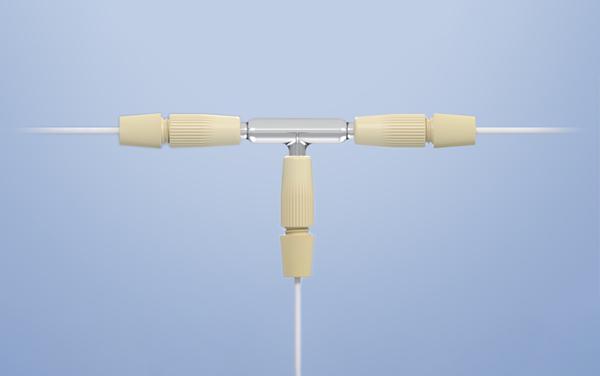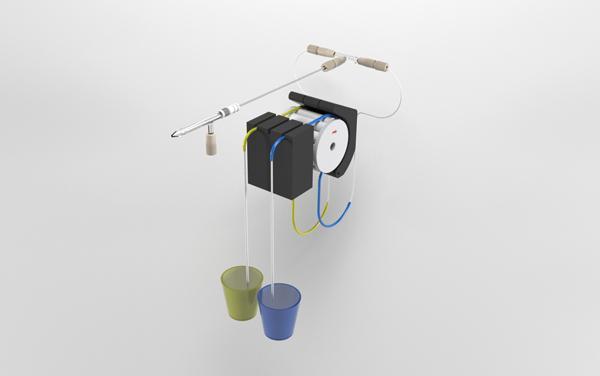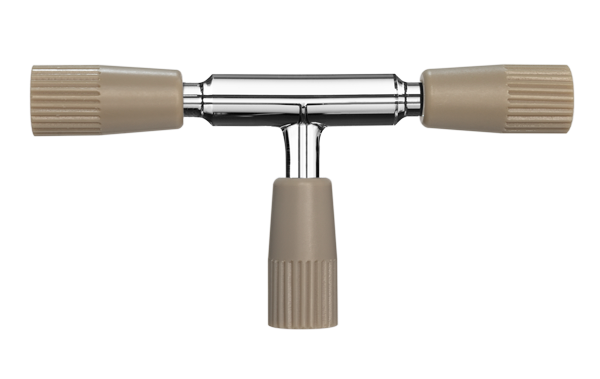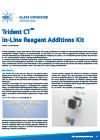Internal standards (IS) are often used in ICP optical and mass spectrometry to correct for matrix-based interferences and improve measurement stability. Similarly, an ionization buffer can be utilized for axial view ICPs to suppress the ionization effects of easily ionizable elements (EIE). When dealing with a large number of samples, this process can be very time-consuming. Other concerns are the risk of contamination and the accuracy of volumetric addition.
A common alternative to volumetric or gravimetric addition of the IS or ionization buffer is to add them in-line using the peristaltic pump and a mixing tee. Glass Expansion developed the Trident In-Line Reagent Additions Kit in 2004 to provide a simple, easy and error-free way to continuously add IS or ionization buffers in ICP spectrometry. The Trident quickly became an ICP industry standard for in-line addition, and we are now pleased to release the Trident CT™ In-Line Reagent Additions Kit.
Introduction
The Trident CT mixing tee is based on the industry-proven design of the Trident, but with the addition of Glass Expansion’s ConstantTorque™ (CT) technology to provide a simple-to-use, leak-free connection for both the internal standard and sample, every time.
The heart of the Trident CT In-Line Reagent Additions Kit is the new CT mixing chamber (Figure 1). It is designed with zero dead volume CT ratchet style ¼-28 fittings on the sample and IS inlets, in addition to the outlet to the nebulizer. The use of inert, metal-free, ratchet fittings provides simple-to-use, leak-free, zero-dead volume connections for the internal standard and sample, every time.

With other mixing chambers, worn or incorrectly fitted connections can leak, injecting a stream of air bubbles into the nebulizer flow, which can degrade short-term analytical precision (%RSD). By using CT ratchet style fittings, the Trident CT eliminates air leaks, optimizing analytical performance.

Like the previous design, the Trident CT provides a complete solution for a simple, easy and error-free way to continuously add IS or ionization buffers in ICP spectrometry. The Trident CT In-Line Reagent Additions Kit is completely modular so that damaged or lost components can easily be replaced. A schematic of the Trident CT is shown in Figure 2 (peristaltic pump shown for reference only, not included).
Experimental
An Agilent® 5100 ICP-OES was used to compare the performance of the original Trident and new Trident CT, in addition to a comparison of volumetric IS addition to the precision achieved using in-line addition with the Trident. The ICP experimental conditions used for these comparisons are listed in Table 2. A 2% HNO3 solution for the blank, a 10 ppm Y in 2% HNO3 for internal standard and a 1 ppm As, Se, Cr, Cu, Mn, Mg, Ni, Na and K in 2% HNO3 for calibration standards and sample were used for the sensitivity and precision comparisons.
| Experimental Parameter | Setting |
| RF power |
1.2 kW |
| Nebulizer gas flow rate |
0.7 L/min |
| Plasma gas flow rate |
12 L/min |
| Auxiliary gas flow rate |
1.0 L/min |
| Read time and number of replicates |
3 sec and 5 replicates |
| Number of samples |
10 for average sensitivity and precision |
| Viewing mode |
Axial |
| Sample pump tubing |
Black-black (0.76 mm ID) (P/N 0.76-BLK-F) |
| Internal standard tubing |
Orange-yellow (0.51 mm ID) (P/N 0.51-OY-F) |
| Pump rate |
12 rpm |
| Nebulizer |
1 mL/min SeaSpray (P/N A13-07-US1) |
| Spray Chamber |
Twister with Helix CT (P/N 20-809-9199HE) |
| Torch |
D-Torch with quartz outer tube (P/N 30-808-3560) |
| Injector ID |
1.8 mm (P/N 31-808-3576) |
Results
A comparison of the IS stability and precision achieved with and without the Trident is shown in Figure 3. The stability of IS signal with the Trident closely matches the sample set that was manually spiked with IS. Over a period of 85 minutes, an IS signal precision of 0.4% RSD is achieved with the Trident compared to 0.7% where the IS was manually added. These results show that the performance of in-line addition with the Trident is at least as precise as a manual addition.
A comparison of the relative signal intensity and IS precision (%RSD) achieved with the new Trident CT and original Trident is shown in Figures 4a and 4b, respectively. Both sensitivity and precision results indicate no significant differences. The 14-line average sensitivity advantage for the new Trident CT compared to the original Trident was 1 %, whereas the average IS precision obtained with both the Trident CT and original Trident was 0.7 %. These test results were important to confirm the new Trident CT design matched the performance of the industry standard, the original Trident design. With identical analytical performance, the new Trident CT simply offers a design to improve the reliability of proper installation and eliminate air leaks due to worn or incorrectly installed fittings.
Since in-line addition with the Trident relies, in part, on the stability of the IS uptake rate via the peristaltic pump, it is important to check the condition of the peristaltic pump tubing and the tension of the clamp. The TruFlo™ real-time sample monitor2 is a very useful tool to diagnose any problems associated with sample tubing or the nebulizer. Pump tubing wear can be slowed by lubricating the pump rollers with the EzyGlide cloth (P/N 70-EZG-CLOTH). This improves precision, reduces drift, and extends the period between recalibrations.

Glass Expansion also offers a complete range of contour flared-end pump tubing, making it easy to connect capillary tubing to small-ID pump tubing. Our contour flared-end pump tubing is available in a range of sizes and materials to suit all applications.
Self-aspiration is an alternative delivery method to the more common peristaltic pump. In some cases, ICP-MS laboratories choose self-aspiration for improved precision by eliminating the pulsations from the peristaltic pump that are more pronounced at very low uptake rates. The Trident CT, when paired with a Glass Expansion concentric nebulizer, can self-aspirate both the sample and IS, providing a means of in-line addition of an IS via self-aspiration. Glass Expansion also offers a complete line of high-quality PTFE encapsulated carbon fiber autosampler probes that can be directly connected to the Trident CT mixing chamber via a zero dead volume connection providing a stable and consistent sample uptake. The previous results showed that the IS stability obtained using the Trident and manual addition is indistinguishable when using self-aspiration.


Conclusion
The results presented in this report indicate that there are no significant differences in the sensitivity or precision achieved with the new Trident CT and the original Trident design. The stability and precision of in-line addition with the Trident CT also match the performance of manual addition. The alternative of in-line addition with the Trident CT drastically reduces sample preparation time, in addition to lowering the risk of contamination and error.
The design improvement of the Trident CT eliminates the chance of worn or incorrectly fitted connections that can leak and inject air bubbles into the nebulizer flow, which can degrade short-term analytical precision (%RSD). The Trident CT In-Line Reagent Additions Kit provides the ICP community with a new industry standard for in-line addition of an IS or ionization buffer with simple-to-use, leak-free, zero-dead volume ratchet connections.
References
- Robert Thomas, “Practical Guide to ICP-MS – A Tutorial for Beginners” 2nd Edition 2008.
- Glass Expansion TruFlo™ Real-Time Sample Monitor
- Glass Expansion October 2015 Newsletter
- Trident CT™ and ConstantTorque™ are trademarks of Glass Expansion Pty Ltd.

